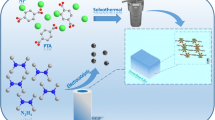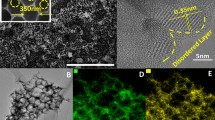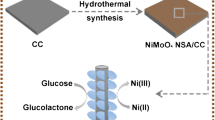Abstract
Ni3(HITP)2 (HITP: 2,3,6,7,10,11-hexaiminotriphenylene) is a very typical 2D electrically conductive metal–organic framework (EC-MOF) material with great promising as active materials in electronic devices. Gas–liquid interface self-assembly is a common method of processing free-standing thin films for this EC-MOF. Owing to the different contact environment during growth process, Ni3(HITP)2 film prepared by gas–liquid interface method has different morphology for up-side surface exposed to air and down-side surface infiltrated in solution. However, the asymmetrical morphology of Ni3(HITP)2 film and its influence on sensing performance have never been implemented. In this work, gas–liquid interface self-assembly method is used to obtain an asymmetrical Ni3(HITP)2 nanofilm in surface morphology with a flat up-side surface and an island-like down-side surface. The surface morphology of as-prepared film has a remarkable influence on the glucose sensing property. The island-like structure for down-side surface film exhibits more excellent glucose sensing performance because of its abundant crystal defect which play an important role in enhancing glucose catalytic oxidation capacity.
Graphical abstract







Similar content being viewed by others
Data Availability
The data that support the findings of this study are available from the corresponding author upon reasonable request.
References
Li H, Li L, Lin RB, Zhou W, Zhang Z, Xiang S, Chen B (2019) Porous metal-organic frameworks for gas storage and separation: status and challenges. EnergyChem 1(1):100006
Li H, Wang K, Sun Y, Lollar CT, Li J, Zhou HC (2018) Recent advances in gas storage and separation using metal-organic frameworks. Mater Today 21(2):108–121
Tang J, Liang Z, Qin H, Liu X, Zhai B, Su Z, Liu Q, Lei H, Liu K, Zhao C, Cao R, Fang Y (2022) Large-area free-standing metalloporphyrin-based covalent organic framework films by liquid-air interfacial polymerization for oxygen electrocatalysis. Angew Chem Int Ed 62(1):202214449
Pascanu V, González Miera G, Inge AK, Martín-Matute B (2019) Metal-organic frameworks as catalysts for organic synthesis: a critical perspective. J Am Chem Soc 141(18):7223–7234
Liu J, Sun W, Zha X, Sun G, Wang Y (2023) A novel hollow nanostructure with charge collection function based on bimetallic MOFs: ameliorating the catalytic reaction of norepinephrine bitartrate in serum. Colloids Surf A: Physicochem Eng Asp 677:132419
Lawson HD, Walton SP, Chan C (2021) Metal-organic frameworks for drug delivery: a design perspective. ACS Appl Mater Interfaces 13(6):7004–7020
Hassan MH, Vyas C, Grieve B, Bartolo P (2021) Recent advances in enzymatic and non-enzymatic electrochemical glucose sensing. Sensors 21(14):4672
Daud AD, Lim HN, Ibrahim I, Endot NA, Gowthaman NSK, Jiang ZT, Cordova KE (2022) An effective metal-organic framework-based electrochemical non-enzymatic glucose sensor. J Electroanal Chem 921(39):116676
Li HY, Zhao SN, Zang SQ, Li J (2020) Functional metal-organic frameworks as effective sensors of gases and volatile compounds. Chem Soc Rev 49(17):6364–6401
Shi Y, Zou Y, Khan MS, Zhang M, Yan J, Zheng X, Wang W, Xie Z (2023) Metal-organic framework-derived photoelectrochemical sensors: structural design and biosensing technology. J Mater Chem C 11(11):3692–3709
Wu M, Wang L, Xu F, Ma G (2022) Preparation of Ni-MOF superstructure-reduced graphene oxide composite for enhanced electrochemical sensing of acetaminophen. Ionics 28(12):5571–5580
Du J, Chai J, Li Q, Zhang W, Tang B (2022) Application of two-dimensional layered Mo-MOF@ppy with high valency molybdenum in lithium-ion batteries. Colloids Surf A: Physicochem Eng Asp 632(41):127810
Yao M, Otake KI, Koganezawa T, Ogasawar M, Asakawa H, Tsujimoto M, Xue Z, Li Y, Flanders NC, Wang P, Gu Y, Honma T, Kawaguchi S, Kubota Y, Kitagawa S (2023) Growth mechanisms and anisotropic softness-dependent conductivity of orientation-controllable metal-organic framework nanofilms. Proc Natl Acad Sci U S A 120(40):2305125120
Dou JH, Arguilla MQ, Luo Y, Li J, Zhang W, Sun L, Mancuso JL, Yang L, Chen T, Parent LR, Skorupskii G, Libretto NJ, Sun C, Yang MC, Dip PV, Brignole EJ, Miller JT, Kong J, Hendon CH, Sun J, Dincă M (2020) atomically precise single-crystal structures of electrically conducting 2D metal-organic frameworks. Nat Mater 20(2):222–228
Zhang S, Li L, Lu Y, Zhang J, Liu D, Hao D, Zhang X, Tian L, Xiong L, Huang J (2022) Chemical sensors based on ionically conductive metal-organic frameworks for selective cadaverine detection. J Mater Chem C 10(14):5497–5504
Li F, Liu L, Liu T, Zhang M (2022) Correction to: Ni-MOF nanocomposites decorated by au nanoparticles: an electrochemical sensor for detection of uric acid. Ionics 28(11):5257
Kulachenkov N, Haar Q, Shipilovskikh S, Yankin A, Pierson JF, Nominé A, Milichko VA (2021) MOF-based sustainable memory devices. Adv Funct Mater 32(5):2107949
Zhu L, Zhang H, Lu Q, Wang Y, Deng Z, Hu Y, Lou Z, Cui Q, Hou Y, Teng F (2018) Synthesis of ultrathin two-dimensional organic-inorganic hybrid perovskite nanosheets for polymer field-effect transistors. J Mater Chem C 6(15):3945–3950
Yan Q, Kanatzidis MG (2021) High-performance thermoelectrics and challenges for practical devices. Nat Mater 21(5):503–513
Cao Y, Wu N, Yang F, Yang M, Zhang T, Guo H, Yang W (2022) Interpenetrating network structures assembled by “string of candied haws”-like ppy nanotube-interweaved NiCo-MOF-74 polyhedrons for high-performance supercapacitors. Colloids Surf A: Physicochem Eng Asp 646:128954
Sheberla D, Bachman JC, Elias JS, Sun CJ, Shao-Horn Y, Dincă M (2016) Conductive MOF electrodes for stable supercapacitors with high areal capacitance. Nat Mater 16(2):220–224
Zhao W, Chen T, Wang W, Jin B, Peng J, Bi S, Jiang M, Liu S, Zhao Q, Huang W (2020) Conductive Ni3(HITP)2 MOFs thin films for flexible transparent supercapacitors with high rate capability. Sci Bull 65(21):1803–1811
Zhao W, Peng J, Wang W, Jin B, Chen T, Liu S, Zhao Q, Huang W (2019) Interlayer hydrogen-bonded metal porphyrin frameworks/mxene hybrid film with high capacitance for flexible all-solid-state supercapacitors. Small 15(18):e1901351
Zhang B, Song S, Li W, Zheng L, Ma X (2021) Asymmetric supercapacitors with high energy density and high specific capacitance based on Ni-Co-Mn multiphase metal structure MOF. Ionics 27(8):3553–3566
Lin Y, Li WH, Wen Y, Wang GE, Ye XL, Xu G (2021) Layer-by-layer growth of preferred-oriented MOF thin film on nanowire array for high-performance chemiresistive sensing. Angew Chem Int Ed 60(49):25758–25761
Song X, Liu J, Zhang T, Chen L (2020) 2D conductive metal-organic frameworks for electronics and spintronics. Sci China Chem 63(10):1391–1401
Liu Y, Wei Y, Liu M, Bai Y, Wang X, Shang S, Chen J, Liu Y (2020) Electrochemical synthesis of large area two-dimensional metal-organic framework films on copper anodes. Angew Chem Int Ed 60(6):2887–2891
Zhang N, Jin Y, Zhang Q, Liu J, Zhang Y, Wang H (2021) direct fabrication of electrochromic Ni-MOF 74 film on ITO with high-stable performance. Ionics 27(8):3655–3662
Jia M, Su J, Su P, Li W (2021) Vapor-assisted self-conversion of basic carbonates in metal-organic frameworks. Nanoscale 13(9):5069–5076
Kim KJ, Culp JT, Ohodnicki PR, Thallapally PK, Tao J (2021) Synthesis of high-quality Mg-MOF-74 thin films via vapor-assisted crystallization. ACS Appl Mater Interfaces 13(29):35223–35231
Li WH, Ding K, Tian HR, Yao MS, Nath B, Deng WH, Wang Y, Xu G (2017) Conductive metal-organic framework nanowire array electrodes for high-performance solid-state supercapacitors. Adv Funct Mater 27(27):1702067
Miner EM, Gul S, Ricke ND, Pastor E, Yano J, Yachandra VK, Van Voorhis T, Dincă M (2017) Mechanistic evidence for ligand-centered electrocatalytic oxygen reduction with the conductive MOF Ni3(hexaiminotriphenylene)2. ACS Catal 7(11):7726–7731
Zhao X, Wang Q, Yu X, Lee Y, Liu HG (2017) Hierarchical composite microstructures fabricated at the air/liquid interface through multilevel self-assembly of block copolymers. Colloids Surf A: Physicochem Eng Asp 516:171–180
Liu K, Wang L, Dong R (2020) Two-dimensional conjugated polymer films via liquid-interface-assisted synthesis toward organic electronic devices. J Mater Chem C 8(31):10696–10718
Ohata T, Tachimoto K, Takeno KJ, Nomoto A, Watanabe T, Hirosawa I, Makiura R (2023) Influence of the solvent on the assembly of Ni3(hexaiminotriphenylene)2 metal-organic framework nanosheets at the air/liquid interface. B Chem Soc Jpn 96(3):274–282
Zasadzinski JA, Viswanathan R, Madsen L, Garnaes J, Schwartz DK (2023) Langmuir-Blodgett films. Science 263(5154):1726–1733
Oliveira ON, Caseli L, Ariga K (2022) The past and the future of Langmuir and LangmuirBlodgett films. Chem Rev 122(6):6459–6513
Chen X, Dong J, Chi K, Wang L, Xiao F, Wang S, Zhao Y, Liu Y (2021) Electrically conductive metal-organic framework thin film-based on-chip micro-biosensor: a platform to unravel surface morphology-dependent biosensing. Adv Funct Mater 31(51):2102855
Kresse G, Hafner J (2000) First-principles study of the adsorption of atomic H on Ni (111), (100) and (110). Surf Sci 459(3):287–302
Kresse G, Furthmüller J (1996) Efficiency of ab-initio total energy calculations for metals and semiconductors using a plane-wave basis set. Comput Mater Sci 6(1):15–50
Kresse G, Furthmüller J (1994) efficient iterative schemes for ab-initio total-energy calculations using a plane-wave basis set. Phys Rev B 54(16):11169–11186
Blöchl PE (1994) Projector augmented-wave method. Phys Rev B 50(24):17953–17979
Perdew JP, Burke K, Ernzerhof M (1997) Generalized gradient approximation made simple. Phy Rev Lett 78(7):1396–1396
Wu G, Huang J, Zang Y, Jun J, Xu G (2017) Porous field effect transistors based on a semiconductive metal organic framework. J Am Chem Soc 139(4):1360–1363
Yang HC, Wu MB, Hou J, Darling SB, Xu ZK (2018) Nanofilms directly formed on macro-porous substrates for molecular and ionic sieving. J Mater Chem A 6(7):2908–2913
Lee YS (2007) Self-assembly and nanotechnology: a force balance approach. Online ISBN:9780470292525. https://doi.org/10.1002/9780470292525
Wu MB, Fan XL, Yang HC, Yang J, Zhu MM, Ren KF, Ji J, Xu ZK (2019) Ultrafast formation of pyrogallol/polyethyleneimine nanofilms for aqueous and organic nanofiltration. J Membrane Sci 570–571:270–277
Sheberla D, Sun L, Blood-Forsythe MA, Er S, Wade CR, Brozek CK, Aspuru-Guzik A, Dincă M (2014) High electrical conductivity in Ni3(2,3,6,7,10,11-hexaiminotriphenylene)2, a semiconducting metal-organic graphene analogue. J Am Chem Soc 136(25):8859–8862
Zhang Y, Qiu T, Jiang F, Amzil S, Wang Y, Fu H, Yang C, Fang Z, Huang J, Dai G (2021) Spindle-like Ni3(HITP)2 MOFs: synthesis and Li+ storage mechanism. Appl Surf Sci 556:149818
Lee T, Kim JO, Park C, Kim H, Kim M, Park H, Kim I, Ko J, Pak K, Choi SQ, Kim ID, Park S (2022) Large-area synthesis of ultrathin, flexible, and transparent conductive metal-organic framework thin films via a microfluidic-based solution shearing process. Adv Mater 34(12):e2107696
Tee SY, Teng CP, Ye E (2017) Metal nanostructures for non-enzymatic glucose sensing. Mater Sci Eng C Mater Biol Appl 70(Pt 2):1018–1030
Li H, Zhang L, Mao Y, Wen C, Zhao P (2019) A simple electrochemical route to access amorphous Co-Ni hydroxide for non-enzymatic glucose sensing. Nanoscale Res Lett 14(1):135
Zhu H, Li L, Zhou W, Shao Z, Chen X (2016) Advances in non-enzymatic glucose sensors based on metal oxides. J Mater Chem B 4(46):7333–7349
Wang F, Chen X, Chen L, Yang J, Wang Q (2019) High-performance non-enzymatic glucose sensor by hierarchical flower-like nickel(II)-based MOF/carbon nanotubes composite. Mater Sci Eng C Mater Biol Appl 96:41–50
Sehit E, Altintas Z (2020) Significance of nanomaterials in electrochemical glucose sensors: an updated review (2016–2020). Biosens Bioelectron 159:112165
Chen Y, Tian Y, Zhu P, Du L, Chen W, Wu C (2020) Electrochemically activated conductive Ni-based MOFs for non-enzymatic sensors toward long-term glucose monitoring. Front Chem 8:602752
Alam AU, Qin Y, Howlader MMR, Hu NX, Deen MJ (2018) Electrochemical sensing of acetaminophen using multi-walled carbon nanotube and Β-cyclodextrin. Sens Actuators, B Chem 254:896–909
Qiao Y, Liu Q, Lu S, Chen G, Gao S, Lu W, Sun X (2020) High-performance non-enzymatic glucose detection: using a conductive Ni-MOF as an electrocatalyst. J Mater Chem B 8(25):5411–5415
Zhao Z, Huang Y, Huang Z, Mei H, Xie Y, Long D, Zhu F, Gong W (2022) Nonenzymetic glucose sensitive device based on morchella shaped nickel-copper layered double hydroxide. Appl Surf Sci 597(12):153658
Liu X, Yang C, Yang W, Lin J, Liang C, Zhao X (2021) One-pot synthesis of uniform Cu nanowires and their enhanced non-enzymatic glucose sensor performance. J Mater Sci 56(9):5520–5531
He G, Wang L (2018) One-step preparation of ultra-thin copper oxide nanowire arrays/copper wire electrode for non-enzymatic glucose sensor. Ionics 24(10):3167–3175
Zhang X, Xu Y, Ye B (2018) An efficient electrochemical glucose sensor based on porous nickel-based metal organic framework/carbon nanotubes composite (Ni-MOF/CNTs). J Alloys and Compd 767:651–656
Lin KC, Yang CY, Chen SM (2015) Fabrication of a nonenzymatic glucose sensor based on multi-walled carbon nanotubes decorated with platinum and silver hybrid composite. Int J Electrochem Sci 10(5):3726–3737
Niu X, Lan M, Zhao H, Chen C (2013) Highly sensitive and selective nonenzymatic detection of glucose using three-dimensional porous nickel nanostructures. Anal Chem 85(7):3561–3569
Gao X, Feng W, Zhu Z, Wu Z, Li S, Kan S, Qiu X, Guo A, Chen W, Yin K (2021) Rapid fabrication of superhydrophilic micro/nanostructured nickel foam toward high-performance glucose sensor. Adv Mater Interfaces 8(7):2002133
Liang X, Sun Q, Liu Z, Pu H, Yin M, Yu J, Yan W, Fa H, Yin W (2023) Performance comparison of non-enzymatic electrochemical glucose sensor with bimetallic NiMo-MOF and CoMo-MOF. Ionics 29(8):3393–3405
Liu XH, Yang YW, Liu XM, Hao Q, Wang LM, Sun B, Wu J, Wang D (2020) Confined synthesis of oriented two-dimensional Ni3(hexaiminotriphenylene)2 films for electrocatalytic oxygen evolution reaction. Langmuir 36(26):7528–7532
Huang Y, Yang H, Xiong T, Adekoya D, Qiu W, Wang Z, Zhang S, Balogun MS (2020) Adsorption energy engineering of nickel oxide hybrid nanosheets for high areal capacity flexible lithium-ion batteries. Energy Storage Mater 25:41–51
Acknowledgements
This work was supported by the National Natural Science Foundation of China (No.: 22205121), Ningxia Natural Science Foundation Project (No.: 2022AAC03303, 2023AAC03354, and 2022AAC03307), Construction of First-Class Disciplines (Pedagogy Discipline) in Ningxia Higher Education Institutions (No. NXYLXK2021B10), First-class Discipline Construction Project (Chemistry) in Higher Education Institutions of Ningxia (Ningxia Normal University), and Engineering Research Center of Liupanshan (No.: HGZD22-19).
Author information
Authors and Affiliations
Contributions
L-aC: conceptualization, resources, funding acquisition, and writing—review and editing. MW: methodology, investigation, formal analysis, and original manuscript writing. XG: investigation and formal analysis. DW: validation and investigation. LC: resources, funding acquisition, and project administration. JG: formal analysis, funding acquisition, and supervision.
Corresponding author
Ethics declarations
Competing interests
The authors declare no competing interests.
Additional information
Publisher's Note
Springer Nature remains neutral with regard to jurisdictional claims in published maps and institutional affiliations.
Supplementary Information
Below is the link to the electronic supplementary material.
Rights and permissions
Springer Nature or its licensor (e.g. a society or other partner) holds exclusive rights to this article under a publishing agreement with the author(s) or other rightsholder(s); author self-archiving of the accepted manuscript version of this article is solely governed by the terms of such publishing agreement and applicable law.
About this article
Cite this article
Cao, La., Wei, M., Guo, X. et al. Conductive Ni3(HITP)2 nanofilm with asymmetrical morphology prepared by gas–liquid interface self-assembly for glucose sensing. Ionics 30, 2375–2385 (2024). https://doi.org/10.1007/s11581-024-05406-7
Received:
Revised:
Accepted:
Published:
Issue Date:
DOI: https://doi.org/10.1007/s11581-024-05406-7




